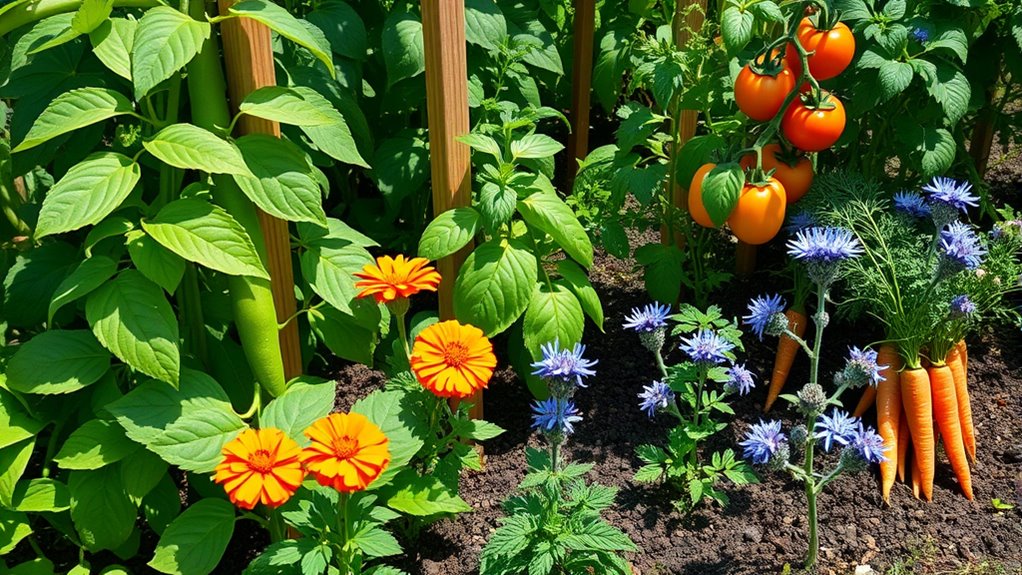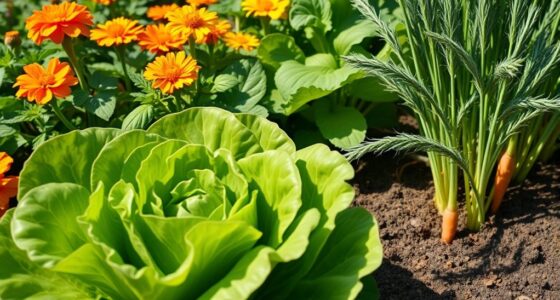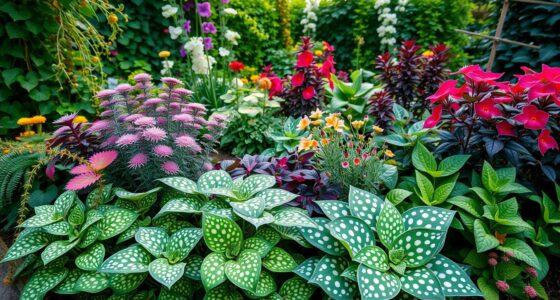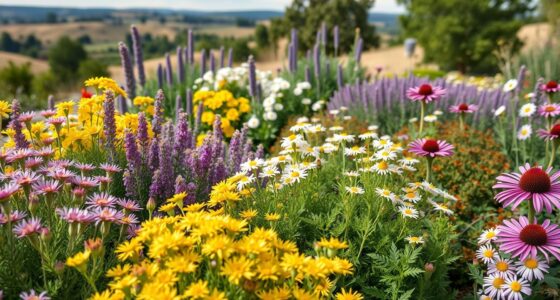Companion planting involves growing different plants close together to support each other’s growth, naturally repel pests, and improve overall health. By pairing herbs like basil with tomatoes or marigolds near vegetables, you can boost flavor and reduce pest problems without chemicals. Understanding plant habits and natural interactions helps you create a resilient, productive garden. Keep exploring these principles, and you’ll discover how to turn your garden into a thriving, pest-resistant ecosystem.
Key Takeaways
- Companion planting involves growing specific plants together to enhance growth, repel pests, and improve flavor naturally.
- Herbs like basil and dill can attract beneficial insects and deter common pests.
- Marigolds and nasturtiums act as natural pest repellents or trap crops, reducing the need for chemicals.
- Proper plant placement considers height, growth habits, and sunlight needs to optimize garden health.
- Implementing plant buddies creates a resilient, eco-friendly garden that promotes healthy, productive plants.

Companion planting is a gardening technique that involves growing different plants close together to benefit each other. It’s an age-old practice that capitalizes on the natural relationships between plants to improve growth, protect against pests, and even enhance flavor. When you understand which plants work well side by side, you can create a more resilient and productive garden with less reliance on chemical interventions.
One effective way to utilize companion planting is by experimenting with herb combinations. Certain herbs are known to attract beneficial insects or repel common pests, making them excellent companions for vegetables and fruits. For example, planting basil near tomatoes not only boosts the flavor of your tomatoes but also helps keep away pests like aphids and whiteflies. Similarly, dill can attract predatory insects such as ladybugs and parasitic wasps that hunt down harmful pests, providing a natural pest control technique that reduces your need for pesticides. By thoughtfully pairing herbs with other plants, you create a natural barrier against pests while enriching your garden’s ecosystem.
Experiment with herbs like basil and dill to naturally attract beneficial insects and repel pests.
Pest control techniques are a vital part of companion planting, especially when you want to keep harmful bugs at bay without resorting to chemical sprays. Many plants emit scents or compounds that make them unattractive to pests, or they attract beneficial insects that prey on pests. Marigolds, for instance, are often used as a natural pest control method; their strong scent deters nematodes and beetles, making them excellent companions for vegetables like beans and tomatoes. Nasturtiums act as trap crops, drawing aphids and whiteflies away from your main crops. Incorporating these plants into your garden not only helps manage pests naturally but also reduces the need for chemical interventions, leading to a healthier environment for your plants and yourself.
Understanding how to combine plants effectively means paying attention to their growth habits and needs. Tall plants, like sunflowers, can provide shade for low-growing herbs such as basil or cilantro, which prefer cooler conditions. Conversely, climbing plants like beans can use trellises to avoid crowding out smaller plants, helping maintain airflow and reducing disease risk. Additionally, somatic therapy techniques such as mindful observation of plant responses can enhance your ability to create successful plant pairings and maintain a balanced garden. When you select the right herb combinations and implement pest control techniques through companion planting, you turn your garden into a balanced, self-sustaining system. This approach not only boosts plant health and yield but also makes gardening more enjoyable and environmentally friendly.
In short, companion planting is a clever, natural way to protect your garden and improve plant health. By choosing the right herb combinations and applying pest control techniques rooted in plant relationships, you create a thriving garden that benefits from nature’s own defenses. With a little planning and observation, you’ll discover how plants can work together to make your gardening efforts easier and more successful.
Frequently Asked Questions
Which Plants Are Best for Beginner Companion Planting?
If you’re new to companion planting, start with easy-to-grow plants like marigolds, basil, and radishes. These act as great pollination partners and attract beneficial insects. Fragrant herbs like mint and thyme not only improve flavor but also repel pests. Plant them near vegetables to boost growth and health. With these beginner-friendly options, you’ll create a thriving garden that benefits from natural pest control and better pollination.
How Do I Prevent Pests With Companion Planting?
Think of your garden as a peaceful village, where each plant plays a role in keeping pests at bay. To prevent pests, you’ll want to implement natural pest deterrents and pest repellent strategies by choosing plants that act as guardians, like marigolds or basil. These companions create a protective barrier, confusing or repelling pests naturally, so your garden remains healthy without chemicals. Your vigilant plant allies make pest control easier and more eco-friendly.
Can Companion Planting Improve Crop Yield?
You can definitely improve your crop yield through companion planting by attracting beneficial insects that help control pests naturally. Additionally, planting certain buddies enhances soil nutrients, promoting healthier plant growth. When you choose the right combinations, your plants benefit from better pollination, stronger roots, and increased resistance to diseases, resulting in higher yields. So, use companion planting strategically to boost productivity and create a more resilient garden ecosystem.
Are There Plants That Should Never Be Planted Together?
You should avoid interplanting incompatible species to prevent harmful plant pairings that could stunt growth or cause disease. Some plants, like fennel and carrots, don’t mix well, while others, such as tomatoes and cabbage, can attract pests or compete for nutrients. By understanding which plants shouldn’t be paired, you’re better equipped to choose compatible species, ensuring a healthy, productive garden without risking crop damage or poor yields.
How Much Space Should I Allocate for Companion Planting?
Imagine a crowded garden bed versus a spacious one—space really makes a difference. For companion planting, you should consider your garden bed dimensions and spacing guidelines carefully. Typically, space plants about 12-18 inches apart to allow airflow and growth. Adjust based on plant size and growth habits, ensuring they don’t compete for nutrients. Proper spacing promotes healthy, thriving plants and maximizes your garden’s productivity.
Conclusion
Now that you understand the basics of companion planting, think of your garden as a well-choreographed dance. When plants work together, they can protect, nourish, and support each other like a harmonious team. By choosing the right plant buddies, you’re planting the seeds for a healthier, more resilient garden. So, embrace this green symphony and watch your garden flourish, proving that when plants unite, they’re unstoppable—like a well-oiled machine in full bloom.









